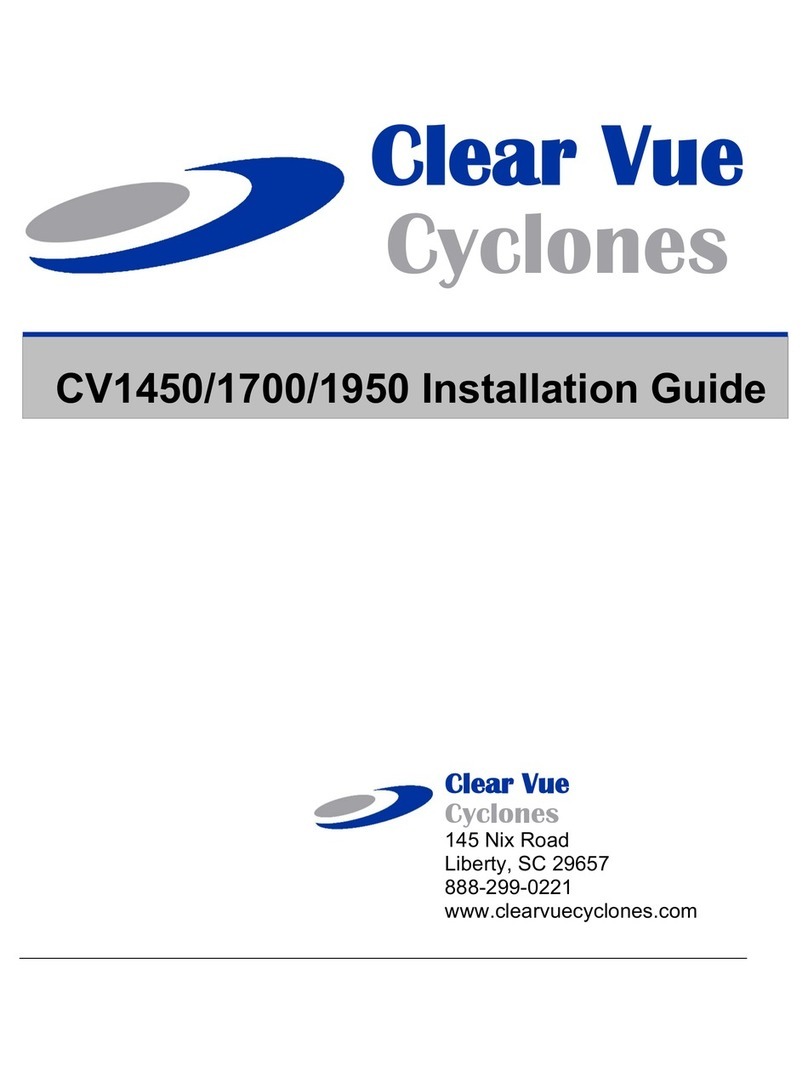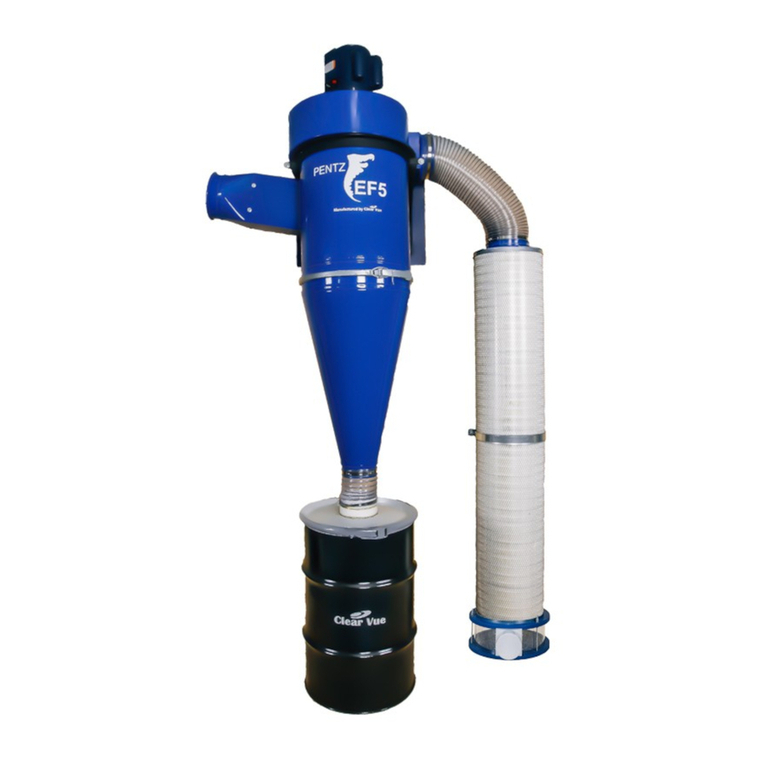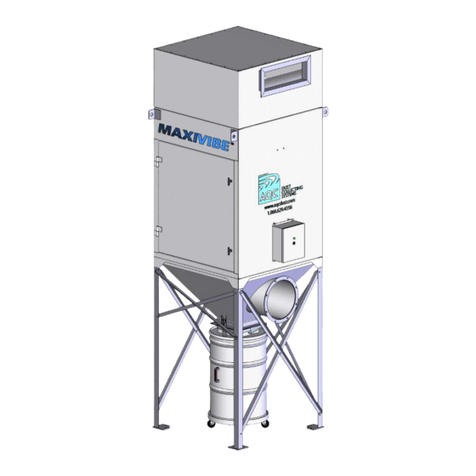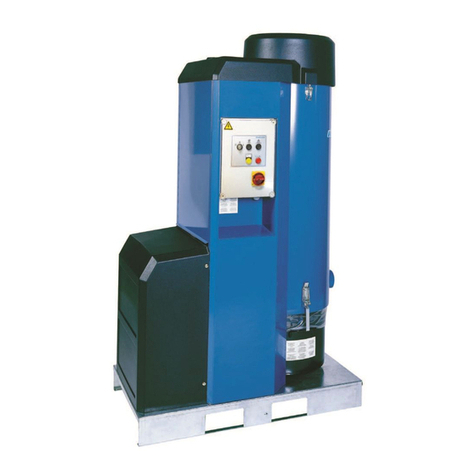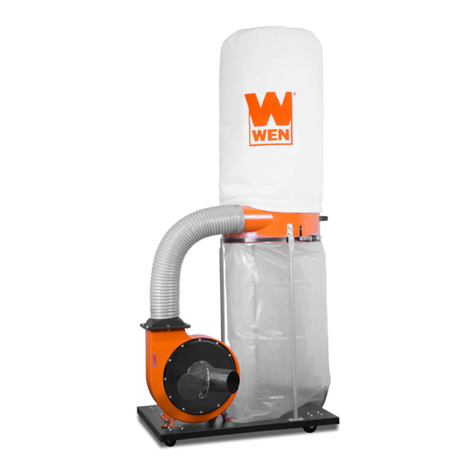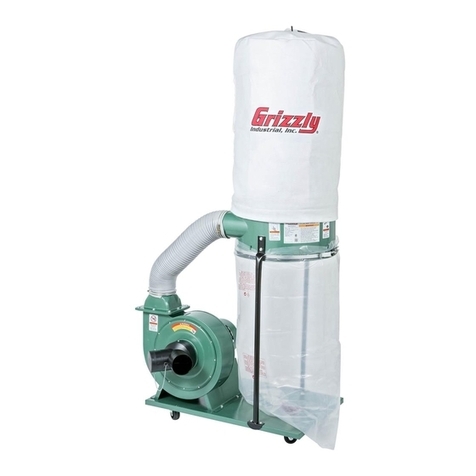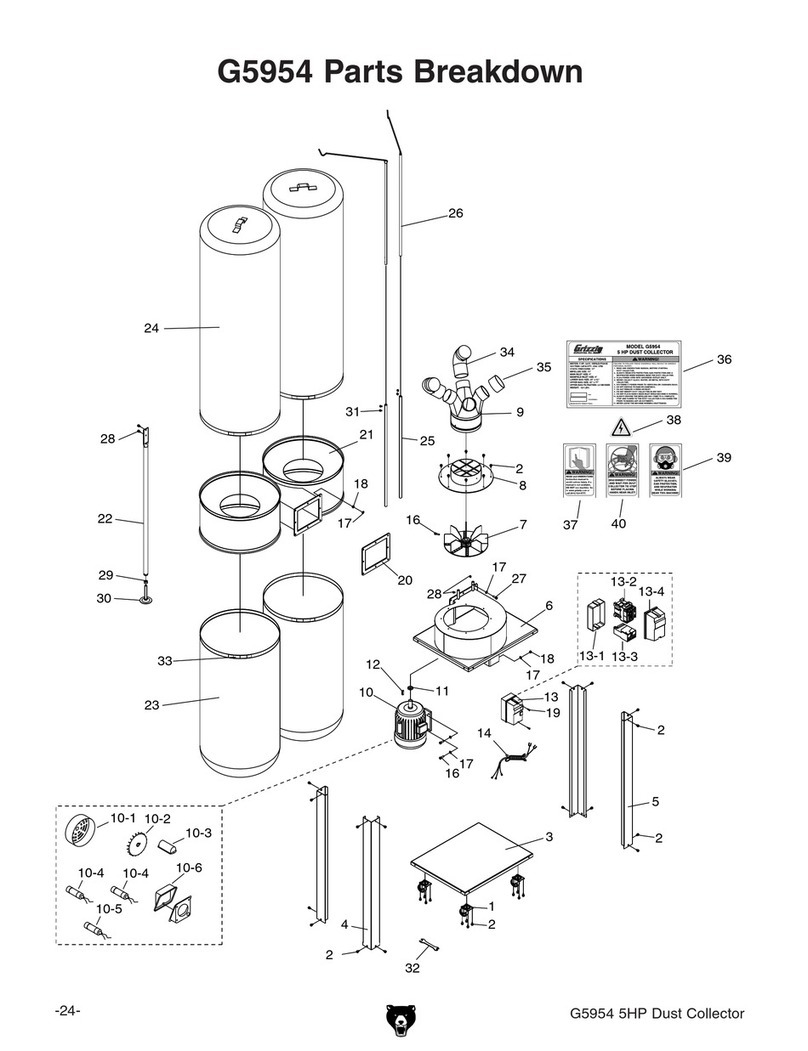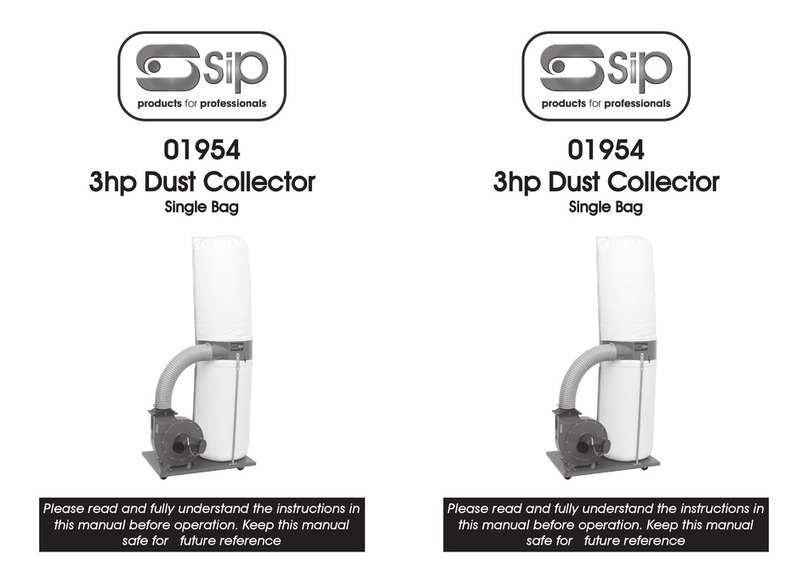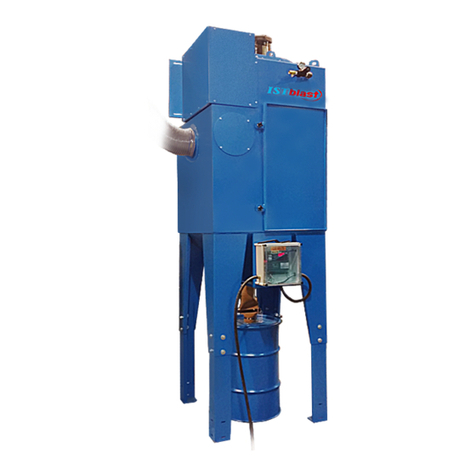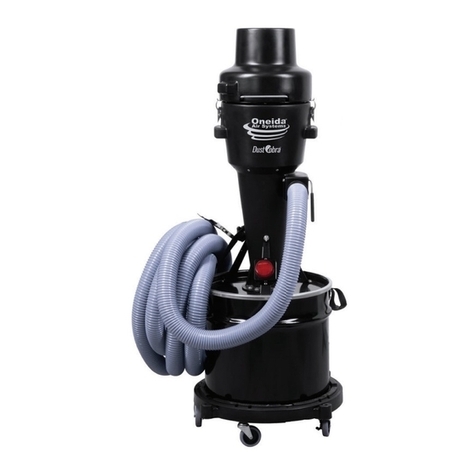Clear Vue Cyclones CV1800 User manual

Clear Vue
Cyclones
Clear Vue
Cyclones
145 Nix Road
Liberty, SC 29657
888-299-0221
www.clearvuecyclones.com
CV1800 and CVMAX Installation Guide

1CV1800 and CVMAX Installation Guide
© Clear Vue Cyclones 2018
Disclaimers & Warnings
WARNING: All persons, by purchasing a motorized dust collection system, motor, or
individual parts from CLEAR VUE CYCLONES, or using these instructions which are
provided as suggestions only, agree to the following disclaimer:
Installing and/or operating this motorized dust collection system, or use of individual
parts, involves the risk of serious bodily injury or even death. The buyer and user
accept total responsibility for any and all operation or use that may lead to personal
injury, economic loss, social distress, other losses, costs and damages. Seller is not
responsible for injuries and or damages of any kind resulting from operating this
motorized dust collection system, motor, or use of individual parts or instructions.
All Rights Reserved, January 2018
Duplication of any part of this manual without expressed written permission from
Bushey Enterprises, Inc. is prohibited.
IMPORTANT!
Minimum Recommended Ceiling Height
A minimum floor-to-ceiling height of 8 feet (96 inches) is required. The content of this manual
is based upon the assembly of the system under an 8’ ceiling.
If your ceiling is lower than this recommended height, please contact us at 888-299-0221 to
discuss your alternate installation options.
Leaks
To maximize performance of your dust collection system, it will be imperative to check for
leaks. Leaks on the suction side of the system will reduce the CFM (cubic feet per minute)
performance levels. We recommend the sealing of all connections in your ducting.
Leaks in the collection drum or at the bottom of the cyclone are a major problem. Such leaks
will cause an up-flow of air through the cyclone and prevent the dust from entering the
collection drum. This will affect the separation efficiency of the cyclone and more dust will
advance through to your filters, which may cause blockage.
Leaks found anywhere after the dust reaches the blower may be blown back into your shop.
This is a hazardous situation and these leaks should be sealed immediately.
Testing for leaks can be done by performing a “smoke test”. With any smoke-producing
device (such as an incense stick), waft the smoke around the various seams of the system.
Leaks in the ducting will cause the smoke to disperse. Leaks around the base of the cyclone
will cause the smoke to be pulled in. Seal any leaks for optimal performance.

This page is intentionally left blank.

3CV1800 and CVMAX Installation Guide
© Clear Vue Cyclones 2018
Table of Contents
Disclaimers & Warnings…………………………………………………………………………1
Dimensional Drawing .........................................................................................4
Cyclone Components.........................................................................................5
Specifications.....................................................................................................6
Installation Tools................................................................................................7
Box Contents......................................................................................................8
Installing Clear Vue Wall Mounting Brackets*....................................................9
Building your own Wall Mounting Brackets......................................................10
Constructing the Hanger Plate & Motor Assembly...........................................11
Attaching the Impeller ......................................................................................13
Hanging the Motor/Impeller Assembly.............................................................13
Assembling the 90° Filter Transition (filtered systems only).............................15
Attaching the 90° Filter Transition (filtered systems only)................................16
Attaching the Straight 8” Exhaust (non-filtered systems only)..........................17
Attaching the Blower Housing to the Cyclone Body.........................................18
Installing the Intake and Leveling the Cyclone.................................................19
Building your own Filter Clean Out Box (filtered systems only)........................20
Assembling the Flangeless Filter Stack (filtered systems only) .......................21
Installing the Filter Stack Assembly (filtered systems only)..............................22
Modifying the Collection Drum Lid ...................................................................23
Installing the Collection Drum and Final Adjustments......................................24
Electrical – Single-Phase Motors .....................................................................25
Electrical – Three-Phase Motors......................................................................27

4CV1800 and CVMAX Installation Guide
© Clear Vue Cyclones 2018
Dimensional Drawing

5CV1800 and CVMAX Installation Guide
© Clear Vue Cyclones 2018
Cyclone Components
*Collection Drum, Wall Mounting Brackets and Filter Clean Out Box sold separately.
Motor
Impeller
90° Filter Transition
(Replaced with Straight
8” Exhaust on non-
filtered systems)
Filters
Filter Clean Out Box*
Collection Drum*
6” Flex Hose
Cyclone Body
Intake Chute
Blower Housing
Hanger Plate
Wall Mounting
Brackets*

6CV1800 and CVMAX Installation Guide
© Clear Vue Cyclones 2018
Specifications
CV1800
CVMAX
System Performance
1,442 CFM at baseline static
pressure of 2.25”
1,935 CFM at baseline static
pressure of 2.25”
Footprint with Filters*
52” x 21-½”
52” x 21-½”
Footprint without
Filters*
45” x 21-½” 45” x 21-½”
Minimum Height**
96”
96”
Weight with Filters***
Single Phase – 164 lbs
Three Phase – 214 lbs
Single Phase – 164 lbs
Three Phase – 214 lbs
Weight without
Filters***
Single Phase – 130 lbs
Three Phase – 180 lbs
Single Phase – 130 lbs
Three Phase – 180 lbs
Blower Assembly
15” steel, backward-inclined impeller
16” steel, backward-inclined impeller
Cyclone Diameter
18”
18”
Intake Size
6.25” ID (sized for 6” sewer & drain
PVC – ASTM D2729 or SDR 35)
8.5” ID (sized for 8” sewer & drain
PVC – ASTM D3034 or SDR 35)
Intake Angle
Upward, 11°
Upward, 11°
Country of Origin
USA
USA
Assembly Time
4-8 hours, with 2 people
4-8 hours, with 2 people
Motor:
Manufacturer
Leeson Motor Company
Leeson Motor Company
HP Rating
5 HP, non-TEC
5 HP, non-TEC
Speed
3,450 rpm
3,450 rpm
Current
Single Phase – 20.8 FLA at 230V
Three Phase – 12.2 FLA at 230V
6.1 FLA at 460V
Single Phase – 20.8 FLA at 230V
Three Phase – 12.2 FLA at 230V
6.1 FLA at 460V
Manual Overload
Protection
Yes Yes
Electrical:
Minimum Circuit Size
Single Phase – 30 amps
Three Phase – 15 amps at 230V
10 amps at 460V
Single Phase – 30 amps
Three Phase – 15 amps at 230V
10 amps at 460V
Minimum
Recommended Wire
Size
10 gauge 10 gauge
Filters:
Manufacturer
Wynn Environmental
Wynn Environmental
Model #
9B300NANO
9B300NANO
Material
100% Nanofiber laminate
100% Nanofiber laminate
Area
300 sq ft each
300 sq ft each
Separation Efficiency
99.999% at 0.5 micron
99.999% at 0.5 micron
MERV Rating
15
15
Dimensions
12.75” OD x 34” H x 8.4” ID
12.75” OD x 34” H x 8.4” ID
* Dimensions based on intake positioned 180° from exhaust. Depth/width will vary depending on rotation.
** Lower ceiling height installations available. Please contact Customer Service at 888-299-0221 for more details.
*** System weight only. Collection drum, Wall Mounting Brackets and Filter Clean Out Box not included.

7CV1800 and CVMAX Installation Guide
© Clear Vue Cyclones 2018
Installation Tools
Items Needed for Installation:
•9∕16” Wrench
•7∕16” Wrench
•3∕32” Hex Key
•Drill
•Level
•Hammer
•6’ Ladder
•Tape Measure
•Box Cutter
•(1) tube of Caulk
oALEX PLUS Acrylic Latex Caulk plus Silicone (color Crystal Clear) is
recommended simply because it dries the clearest.Other brands/types may
be used.
•Collection Drum with Lid
oContainer must be round, airtight, and not subject to collapse.
oTraditional installation allows 27” of space for the Collection Drum. Taller
drums require system to be mounted higher.
oSee the section on Modifying the Collection Drum Lid for additional items that
may be needed.
•½” thick by 1” wide gasket or weather stripping (for tight seal on the lid of the
Collection Drum).
Items Needed to build Wall Mounting Brackets*:
•(½) sheet of ¾” plywood
•(1) 2” x 4” x 8’
•(8) #12 x 3” (or longer) screws
•(20) 1-½” screws
•(8) #12 x 2-¼” screws
•Wood glue
Items Needed to build Filter Clean Out Box*:
•(½) sheet of ¾” plywood or MDF
•Wood glue
•Nails
•½” thick by 1” wide gasket or weather stripping
*Wall Mounting Brackets and Filter Clean Out Box are available for purchase at
www.clearvuecyclones.com.

8CV1800 and CVMAX Installation Guide
© Clear Vue Cyclones 2018
Box Contents
Cyclone Box:
•Cyclone body
•Intake chute
•6” length of 6” flex hose
•(2) 6” flex hose clamps
•Relay (not included with purchase of
Electrical Box)
•Filter Clamp and hardware (filtered
systems only):
o(1) ¼”-20 x 1” bolt
o(1) ¼”-20 flat washer
o(1) ¼”-20 wing nut
•Straight 8” Exhaust (non-filtered systems
only)
Materials Box:
•Blower Housing with motor plate
•Impeller
•Hanger Plate
•Wall Mounting Brackets (if purchased)
•90° Transition sides and end plate
(filtered systems only)
•90° Filter Transition inner and outer
plastic sides (filtered systems only)
•Hardware kit:
o(4) 3∕8” x 1-¼” bolts
o(4) 3∕8” flat washers
o(4) 3∕8” lock washer
o(8) 5∕16” x 1” rubber bushings
o(4) #6-18 x 3∕8” pan head screws
o(6) #6 x 1-5∕8” sheet rock screws
o(7) #6 x 1-¼” sheet rock screws
o(8) ¼”-20 lock washers
o(28) ¼”-20 flat washers
o(24) ¼”-20 nuts
o(4) ¼”-20 x 7” threaded rods
o(4) ¼”-20 x 1-½” hex bolts
•Taper-lock bushing with (3) bolts
Motor Box:
•Leeson motor
oMotor key will be taped to
motor – do not discard!
Filters (if applicable):
•Shipped separately from Wynn
Environmental for continental US
orders
Filter Clean Out Box (purchased separately):
•Filter Clean Out Box
Electrical Box (purchased separately):
•Shipped separately for continental
US orders
•Electrical junction box with relay
•6’ whip
•(1) remote
Check the contents of your boxes as
soon as possible to verify there was no
damage sustained during shipment. If
there are any issues, please contact
Customer Service at 888-299-0221.

9CV1800 and CVMAX Installation Guide
© Clear Vue Cyclones 2018
Installing Clear Vue Wall Mounting Brackets*
1. Assemble legs:
a. Secure (1) horizontal leg and (1) vertical leg of the
bracket using bolts and nuts provided. Orientation of
bolt-head does not matter.
b. Follow same procedure for second bracket.
2. Measure where top of the crossbar will be mounted on the
wall and mark accordingly. Our 8’ installation requires the
top edge of crossbar to be mounted at 95.5”.
If your ceilings are higher than 8’ and you are using a collection drum that is
taller than 27”, you will need to increase the mounting height of your brackets
accordingly. The measurement does not need to be exact – a longer length
of flex hose can be used between the base of the cyclone and collection drum
to take up any excess height.
3. Slide assembled legs onto crossbar.
a. Position legs accordingly – the legs can be
spaced so that the hanger plate is situated either
lengthwise or widthwise.
4. Mount crossbar to the studs of the wall, using 3” lag
bolts (not included).
a. Note: some customers may choose to mount the
brackets to a piece of plywood before mounting to
the studs. Ensure the plywood extends the entire assembled height of the brackets.
If you choose to mount the crossbar to the wall first before attaching the legs, use
the inner holes for mounting as the legs will not slide past the lag bolts. Once
legs are attached, you can the fasten lag bolts in the outer set of holes as well.
*For brackets purchased after 02/01/2016. Please contact Customer Service for
assembly instructions for brackets purchased prior to this date.
Horizontal
legs
Vertical legs
Crossbar

10 CV1800 and CVMAX Installation Guide
© Clear Vue Cyclones 2018
Building your own Wall Mounting Brackets
These brackets are intended for use with single-phase systems only. If mounting a
three-phase system, the brackets must be welded steel to support the motor weight.
Note: Wall Mounting Brackets are available for purchase at www.clearvecyclones.com.
1. Cut the bracket components:
15” Blower (CV1800)
16” Blower (CVMAX)
(2) vertical legs from 2” x 4” x 8’
9” long
9” long
(2) horizontal legs from 2” x 4” x 8’
18” long
20” long
(1) bracket back from ¾” plywood
12” x 26”
12” x 26”
(2) bracket sides from ¾” plywood
9” x 19-½”
9” x 21-½”
2. Join the vertical and horizontal legs:
a. Using (2) #12 x 2-¼” or longer screws, join the vertical
(shorter) legs to the horizontal (longer) legs by driving the
screws through the vertical leg into the end grain of the
horizontal leg.
b. Repeat for second bracket.
3. Attach the sides to the bracket:
a. Glue the bracket sides to the “L” bracket. Reinforce
with (10) 1-½” screws.
b. If desired, trim side brackets down to triangular shape.
c. Repeat for second bracket.
4. Mount brackets to the wall:
a. Mount the top of the bracket back 96” above the floor.
If your ceilings are higher than 8’ and you are using a collection drum that is taller than
27”, you will need to increase the mounting height of your brackets accordingly. The
measurement does not need to be exact – a longer length of flex hose can be used
between the base of the cyclone and collection drum to take up any excess height.
b. Attach the bracket back to the wall by driving at least (8) or more #12 x 3” screws
through the bracket into the wall studs.
These screws will be holding the weight of the entire unit, so #12 x 3” or longer
screws are recommended.
5. Attach the assembled bracket sides to the
mounted bracket back using (4) #12 x 2-¼”
screws. The tops and outside edges of the
components should align.

11 CV1800 and CVMAX Installation Guide
© Clear Vue Cyclones 2018
Constructing the Hanger Plate & Motor Assembly
1. Assemble the threaded rod hardware:
a. Set up (4) threaded rods with the items shown. Leave about 2 to 2 ½” between item
groups.
2. Locate the motor plate – it is the round disc secured to the top of the blower housing with (6)
clips. Separate it from the blower housing by removing the (6) clips and associated
hardware.Set these clips and hardware aside.
3. Insert (1) threaded rod assembly into each hole of the
motor plate, with the hardware situated down.
a. Thread rod into T-nuts until they almost “bottom out”.
The T-nuts are installed on the rabbet side, which is
facing down in the picture. Make sure the T-nuts are on
the bottom side before inserting the threaded rod from
the top.
b. Once installed, the top washer should be approximately
4” above the motor plate.
c. Repeat for (3) remaining threaded rod assemblies.
4. Slide the hanger plate onto the threaded rod assemblies.
The strips on the hanger plate should be facing UP.
5. Install the remaining hardware above the
hanger plate as pictured.
a. Leave the ¼”-20 nuts above and
below the hanger plate loose as
they will be used to level the
cyclone after it is hung.
¼”-20 flat
washer
¼”-20 lock
washer
¼”-20
nut
¼”-20
nut
¼”-20 flat
washer
5∕
16
” x 1”
rubber
bushing
2 – 2 ½”
4”
¼”-20 flat
washer
5∕
16
” x 1” rubber
bushing
¼”-20 nuts

12 CV1800 and CVMAX Installation Guide
© Clear Vue Cyclones 2018
6. Stand the motor on end, with the shaft facing up towards the ceiling.
7. Attach the motor to the hanger plate assembly:
a. Turn the hanger plate assembly over so
that the hanger plate is down and set it
on the motor. Be sure the holes on the
motor plate align with those on the face
of the motor.
8. Install (1) 3∕8” x 1-¼” bolt through each of the
holes on the motor plate into the holes on the
face of the motor, using (1) 3∕8” lock washer and
(1) 3∕8” flat washers per bolt.
9. Tighten each motor bolt securely.
Completed Hanger Plate & Motor Assembly
Do NOT turn the motor on until the system is completely
assembled, including the collection drum. Doing so may cause
the circuit breaker to trip, physical damage to the system and/or
bodily harm.

13 CV1800 and CVMAX Installation Guide
© Clear Vue Cyclones 2018
Attaching the Impeller
Improper installation of your impeller can lead to the impeller coming off
during operation. Significant damage to your system and/or bodily harm
can result. It is imperative that you read and follow these directions
closely. Detailed assembly videos can be found under the Education
Center/Assembly Instruction section of our website at
www.clearvuecyclones.com.
1. Remove the MDF packing plate affixed to the impeller and discard it.
2. Locate the taper-lock bushing (and screws). It will either be installed on the impeller, or packed in
a small box, inside of the materials box.
a. If the taper-lock is installed on the impeller, remove it by inserting the (3) taper-lock
bolts into the smaller, threaded holes in the bushing and tightening them down until
taper-lock releases from the impeller hub.
b. Pry the taper-lock slightly open by inserting a flat-head screwdriver into the slit.
3. Attach the taper-lock bushing to the impeller:
a. Insert the (3) taper-lock bolts into the larger, non-threaded holes in
the taper-lock bushing.
b. Slide the taper-lock into the hub in the center of the impeller, lining up
the taper-lock bolts with the threaded holes on the impeller.
c. Finger-tighten the bolts to secure them in place.
Make sure the taper-lock bolts are inserted through the larger, non-
threaded holes in the taper-lock bushing, into the threaded holes of the
impeller. The alternate set of holes is used for impeller removal only.
4. Position the impeller:
a. Slide the impeller onto the motor shaft, with the taper-lock bushing facing up.
b. Insert the motor key and lightly tighten the setscrew using a 3∕32” hex key until it cannot
fall out.
c. For single phase motors, lift the impeller so that the taper-lock is flush with the top of the
motor shaft.
d. For three phase motors, lift the impeller so that the taper-lock sits ¼” below the top of
the motor shaft.
5. Tighten the taper-lock bolts:
a. Consecutively tighten each taper-lock bolt by a ¼
revolution, until they are all tight.
The tightening of each bolt will cause the subsequent bolts
to feel as if they’ve loosened.
b. Repeat this process until each bolt is torqued to the
manufacturer’s specification of 5 ft/lbs.
Upon completion, there should be a minimum of ¼”
clearance between the back of the impeller and the motor
bolts intalled in the motor plate. There may also be up to a
1∕16” – 1∕8” gap between the taper-lock bushing and the impeller hub.
6. Firmly tighten the setscrew against the motor key using a 3∕32” hex key.
≥¼”
1∕16” – 1∕8”

14 CV1800 and CVMAX Installation Guide
© Clear Vue Cyclones 2018
Hanging the Motor/Impeller Assembly
If you purchased an Electrical Box with your system, it is recommended that you wire the
6’ whip into the wiring box of the motor first, prior to hanging the motor/impeller assembly.
Please refer to the Electrical Box instruction sheet for more detail.
1. Hang the motor/impeller assembly:
a. With the help of your installation partner, turn the motor/impeller assembly over so that
the fins of the impeller are facing downward.
b. Rotate the assembly so that the wiring box on the motor will be accessible, once
mounted.
b. Slide the assembly onto the Wall Mounting brackets – the hanger plate can be
situated either lengthwise or widthwise, depending on installation.
2. The motor/impeller assembly will be secured to the Wall Mounting Brackets after the cyclone
has been installed. This allows for the ability to move the motor/impeller assembly in or out a
couple of inches to make installation of the cyclone easier.
Do NOT turn the motor on until the system is completely
assembled, including the collection drum. Doing so may cause
the circuit breaker to trip, physical damage to the system and/or
bodily harm.
Motor Wiring Box

15 CV1800 and CVMAX Installation Guide
© Clear Vue Cyclones 2018
Assembling the 90° Filter Transition (filtered systems only)
1. Begin by inserting the outer and inner plastic sides into the
grooves of the side plates to form the transition.
2. Slip the assembled sides of the transition into the slot of the
round end plate
a. The straight ends of the two MDF side plates should be
seated into the groove of end plate.
3. Secure the filter transition end plate:
a. Drill (4) small pilot holes in the bottom of the round
end plate.
b. Attach the transition end plate using (4) #6 x 1-¼”
sheet rock screws.
Do not caulk the seams of the 90° Filter Transition until it is installed on the blower
housing.

16 CV1800 and CVMAX Installation Guide
© Clear Vue Cyclones 2018
Attaching the 90° Filter Transition (filtered systems only)
1. Using a 7/16” wrench, loosen the (4) bolts
closest to the rectangular opening on the
blower housing and expand it slightly.
2. Slip the 90° filter transition onto the blower
housing with the sides of the transition
outside of the plastic wrapper of the
blower.
a. Tighten the bolts on the blower
housing to clamp the transition in
place.
3. With the transition positioned, drill (2) holes through each side of the transition where it
overlaps with the blower housing plastic wrapper, using a 5∕16” bit.
4. Insert a ¼”-20 x 1-½” hex bolt into each hole
from the inside, with the ends pointed
towards the exterior of the assembly.
a. Secure the transition in place using a
¼”-20 lock washer, ¼”-20 flat washer
and a ¼”-20 nut.
b. Repeat for (3) remaining holes.
5. Center the two plastic sides of the transition
between the blower housing and the
transition end plate by sliding them up or
down accordingly.
6. Caulk the seams of your blower housing (where plastic meets MDF), as well as where the
90° filter transition attaches to the blower housing, using clear silicone caulk. Be sure to cover
all seams.
Sealing your blower housing and transition is very important. If there are any leaks, the
unit will blow fine dust into your shop.
Do not remove the white block of wood mounted to the inside of your
blower housing. This block counters the sound as the impeller blade
passes by the larger opening of the blower housing, reducing noise.

17 CV1800 and CVMAX Installation Guide
© Clear Vue Cyclones 2018
Attaching the Straight 8” Exhaust (non-filtered systems only)
1. Using a 7/16” wrench, loosen the (4) bolts
closest to the rectangular opening on the
blower housing and expand it slightly.
2. If not already installed, place the white
mounting sticks on the outside of the blower
housing’s plastic wrapper.
a. The blocks will be marked left and right.
b. Line up the pre-drilled holes on the
blocks with the holes on the plastic
wrapper.
c. Tighten the bolts on the top of the
blower housing to clamp the mounting
sticks in place.
3. Place the straight 8” exhaust over the opening of the blower housing and line up the pre-
drilled holes with the holes on the mounting sticks.
4. Insert a ¼”-20 x 1-½” hex bolt into each
hole from the inside, with the ends pointed
towards the exterior of the assembly.
a. Secure the transition in place using
a ¼”-20 lock washer, ¼”-20 flat
washer and a ¼”-20 nut.
b. Repeat for (3) remaining holes.
5. The exhaust is sized to receive 8” sewer
and drain PVC, which is then used to duct
to the final termination point outdoors.
7. Caulk the seams of your blower housing (where plastic meets MDF), as well as where the
straight 8” exhaust attaches to the blower housing, using clear silicone caulk. Be sure to
cover all seams.
Sealing the exhaust is very important. If there are any leaks, the unit will blow fine dust
into your shop.
Do not remove the white block of wood mounted to the inside of your
blower housing. This block counters the sound as the impeller blade
passes by the larger opening of the blower housing, reducing noise.

18 CV1800 and CVMAX Installation Guide
© Clear Vue Cyclones 2018
Attaching the Blower Housing to the Cyclone Body
1. Place the cyclone body, right-side up and well-supported, in a drum or bin to keep the unit
from tipping over. If a drum or bin is not available, the cyclone’s shipping box can be
shortened and used for support as well.
2. Set the blower housing on top of the cyclone.
Determine the desired orientation of the cyclone intake
relative to the exhaust opening on the blower housing.
The position of the intake can be rotated in any
direction with respect to the exhaust. This will not
affect system performance in any way.
3. Secure the blower housing to the top of the cyclone
body with (6) #6 x 1-5∕8” sheet rock screws, using the
pre-marked divots on the blower housing bottom as
guides.
4. With the assistance of a helper, lift the cyclone body
up so that the impeller is seated within the blower
housing and the motor plate is aligned with the opening on the top of the blower housing.
a. If no help is available, remove the cyclone from the drum or bin used to secure it in
step 1 and place a piece of plywood across the top of the container. Carefully position
the cyclone body on top of the plywood and under the motor assembly, ensuring it
does not tip, maintaining contact at all times. Slip a series of boards under the cyclone
to lift the unit until the motor plate is correctly aligned with the top of the blower
housing.
5. Secure the blower housing to the motor plate:
a. Reinstall the (6) clips removed earlier using using (1)
¼”-20 x 1-½” hex bolt, (1) ¼”-20 lock washer, and
(1) ¼”-20 flat washer per clip.
b. Leave the clips loose enough to allow for rotation of
the cyclone.
The motor plate will not sit flush with the top of the blower housing by design.
It is not necessary to seal the seam between the cyclone and blower housing, or
the seam between the blower housing and motor plate, with silicone.

19 CV1800 and CVMAX Installation Guide
© Clear Vue Cyclones 2018
Installing the Intake and Leveling the Cyclone
1. Rotate the cyclone, if necessary, so the portion of the intake chute extending from the cyclone
body is accessible.
2. Attach the intake transition to the cyclone by lining
up the pre-drilled holes and inserting (4) #6-18 x 3∕8”
pan head screws.
3. Seal the seam between the chute and transition with
silicone.
4. Rotate the cyclone, if necessary, into position and
tighten the (6) clips on the top of the blower housing.
The position of the cyclone/blower housing
assembly can be rotated in any direction. This
will not affect system performance in any way.
5. Place a level across the top of the blower housing to ensure that the cyclone is level.
a. To raise the system upward, tighten the ¼”-20 nuts above the hanger plate, moving
them down the threaded rod assembly towards the floor. Loosen the ¼”-20 nuts
below the hanger plate as needed.
b. To lower the system downward, loosen the ¼”-20 nuts above the hanger plate,
moving them up the threaded rod assembly towards the ceiling.
When finished, the cyclone should be within a ¼” of being level in all directions.
6. Tighten the ¼”-20 nuts above and below the hanger plate so they are snug without causing
the bushings to bulge.
Wonder why there’s a hole in the side of your cyclone?
This hole allows for a small amount of air movement in the area above the inner ramp in
order to prevent dust from accumulating over time.
Do not plug this hole!
This manual suits for next models
1
Table of contents
Other Clear Vue Cyclones Dust Collector manuals
Popular Dust Collector manuals by other brands
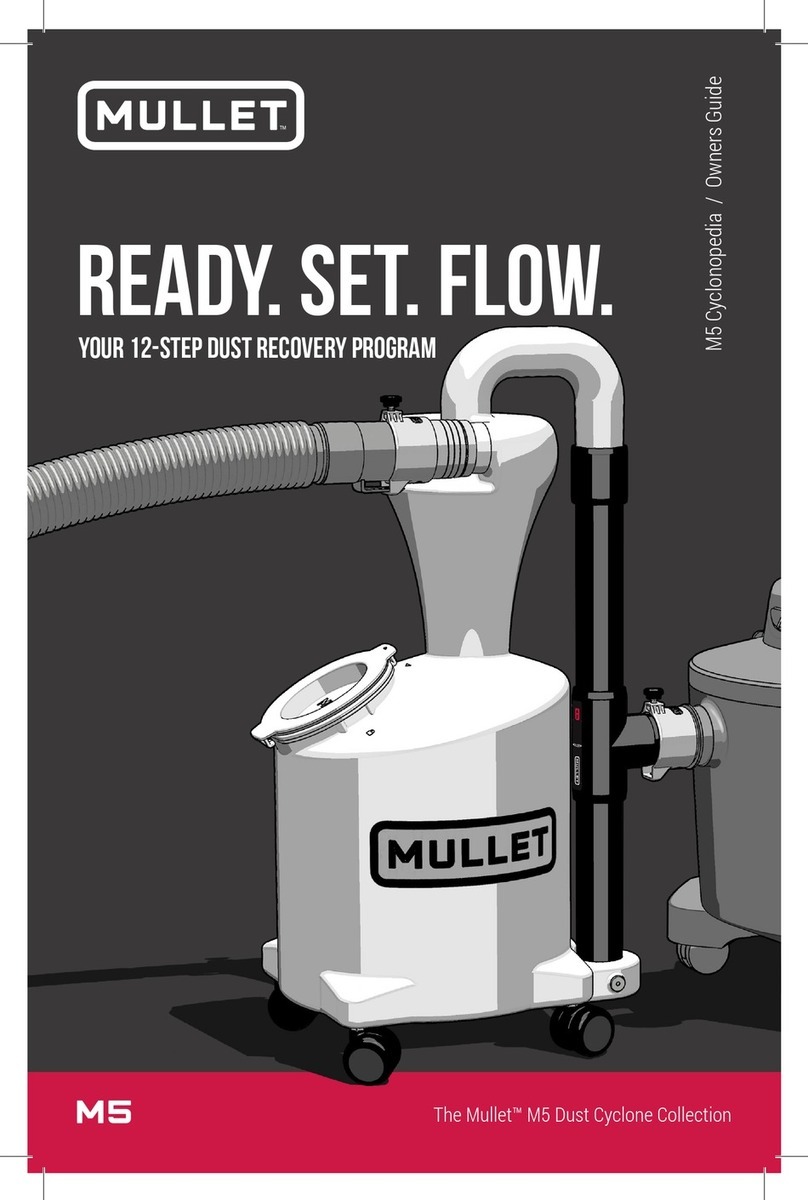
Mullet
Mullet Dust Cyclone M5 owner's guide
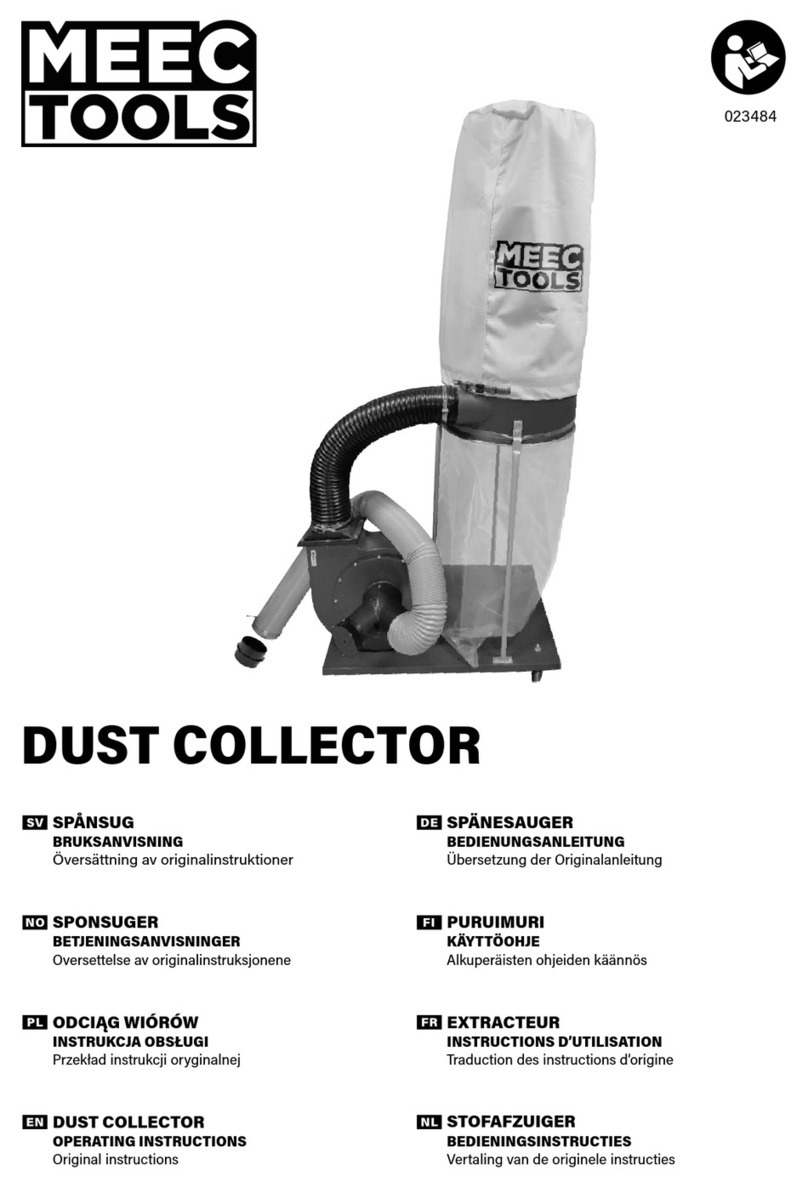
Meec tools
Meec tools 023484 operating instructions
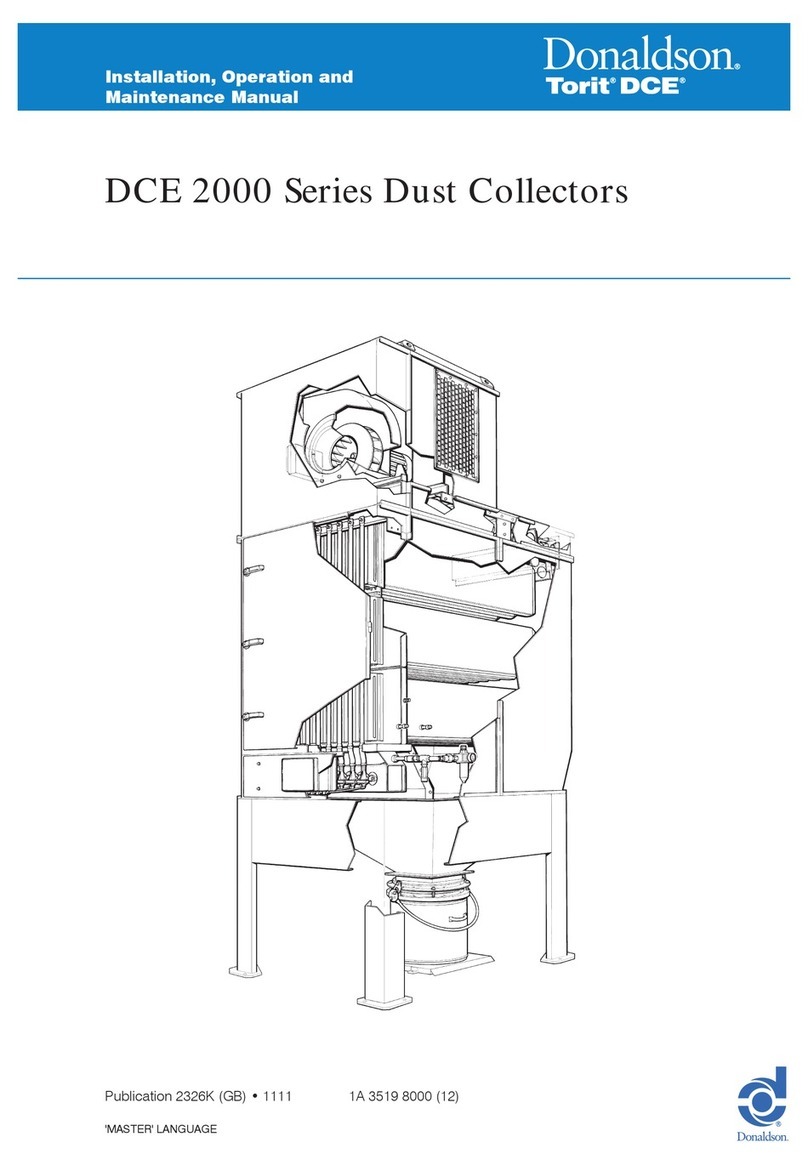
Donaldson Torit
Donaldson Torit DCE 2000 Series Installation, operation and maintenance manual
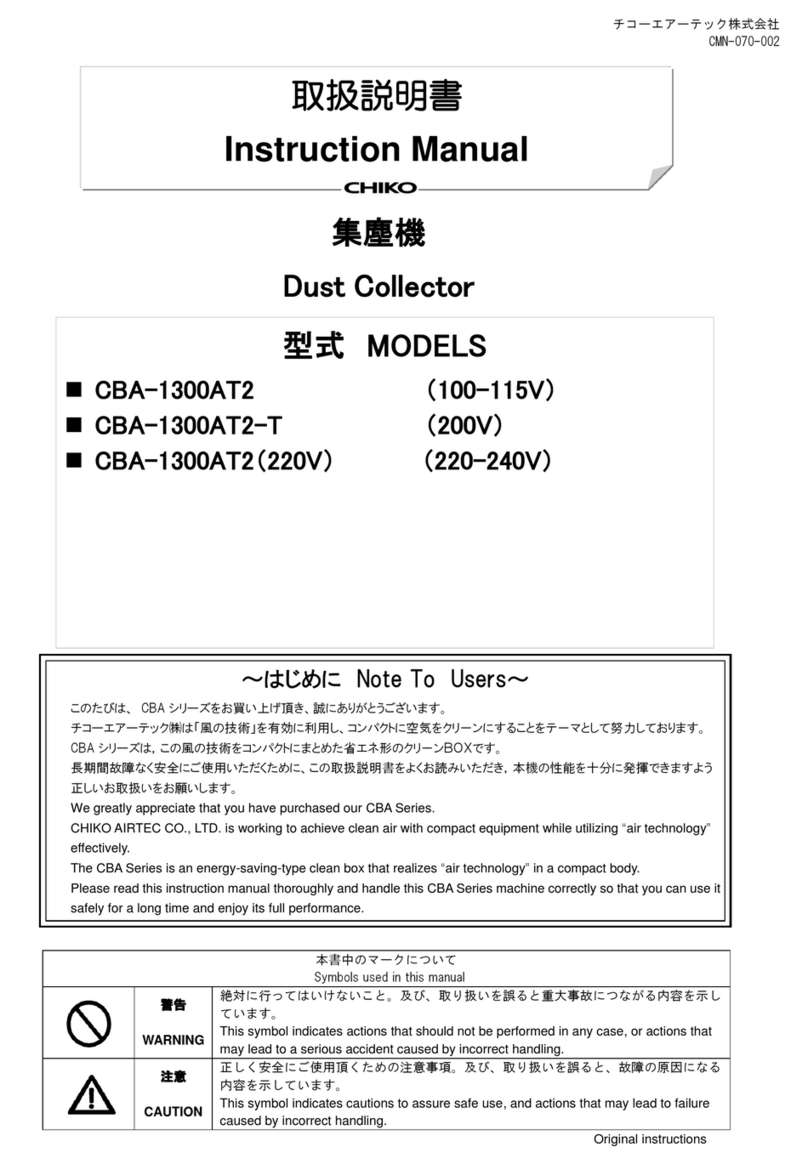
CHIKO AIRTEC
CHIKO AIRTEC CBA-1300AT2 instruction manual
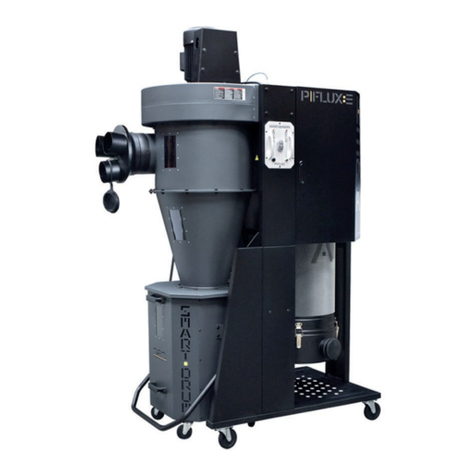
IGM
IGM LAGUNA PFlux3 operating instructions
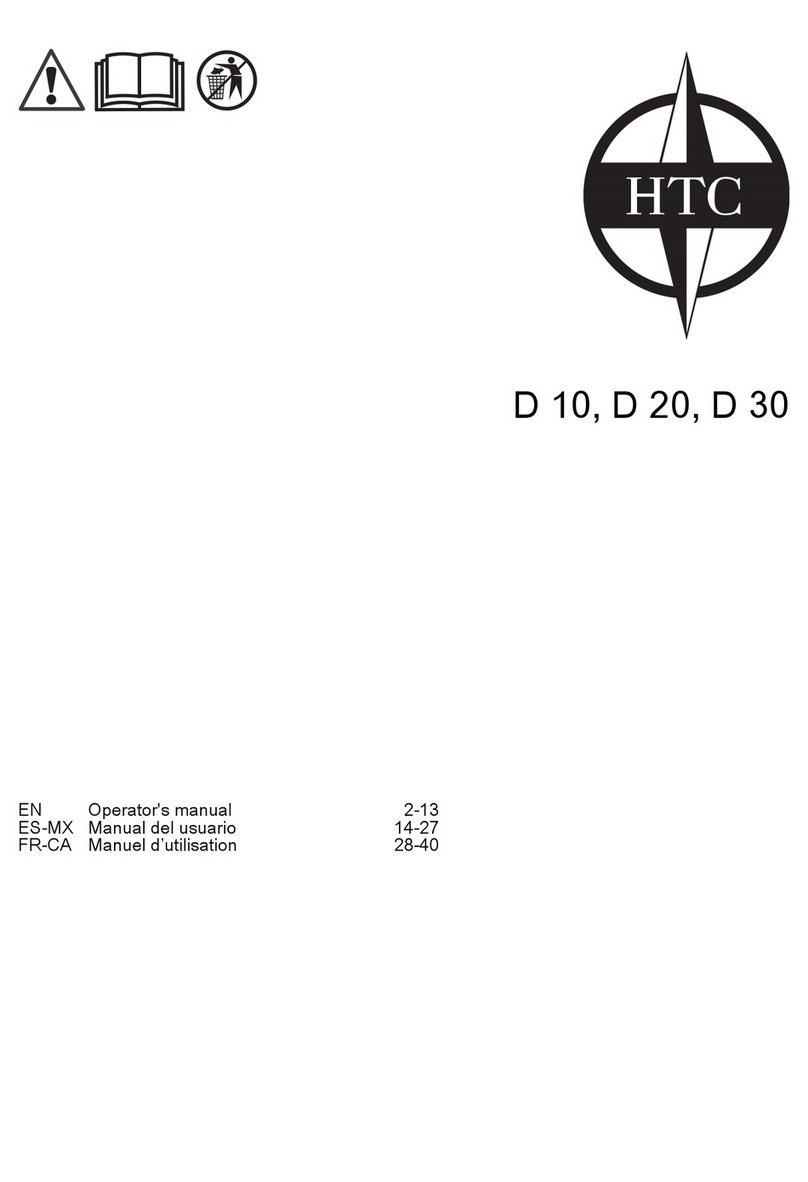
HTC
HTC D 10 Operator's manual
